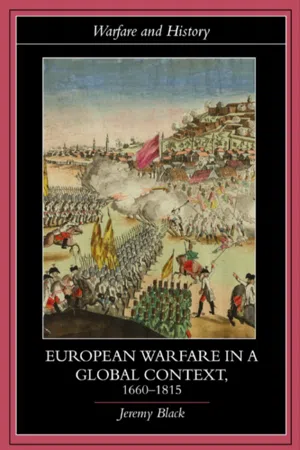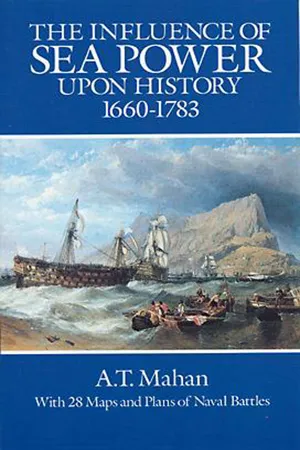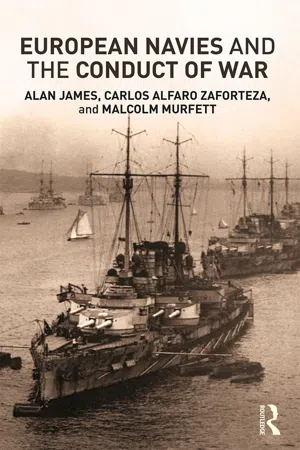History
Seven Years' War
The Seven Years' War was a global conflict fought between 1756 and 1763, involving major European powers and their colonies. It was sparked by territorial disputes and power struggles, with fighting taking place in Europe, North America, the Caribbean, Africa, and Asia. The war resulted in significant territorial and colonial changes, and it set the stage for future conflicts, including the American Revolutionary War.
Written by Perlego with AI-assistance
Related key terms
12 Key excerpts on "Seven Years' War"
- eBook - ePub
A History of War
From Ancient Warfare to the Global Conflicts of the 21st Century
- Chris McNab(Author)
- 2022(Publication Date)
- Arcturus(Publisher)
In naval use, other types of shell included bar shot and chain shot, which featured double balls or weighted ends attached, respectively, by a solid bar or a length of chain. These munitions were designed to scythe through sails and rigging.The Seven Years’ War
The Seven Years’ War was termed ‘the first world war’ by none other than British Prime Minister Winston Churchill. This perception has some justification. Fought between 1756 and 1763, the war had multiple theatres – Europe, the Americas, West Africa, India and the Philippines – and dragged in most European powers plus many combatants beyond.In many ways, it makes more sense to view the Seven Years’ War as several related but largely separate conflicts, unified by the combatants and also the international war between naval powers. The Seven Years’ War in the North American theatre is known more regionally as the French and Indian War. By the middle part of the 18th century, France was largely in control of Canada (known as ‘New France’), while the eastern seaboard of what would become the USA was governed by the 13 colonies of Great Britain. Friction between these two powers, and also with the Native Americans whom European colonialism attempted to overwrite, was long-standing, with the French and British already in a state of semi-conflict along the frontier region. Fighting began in earnest in 1754 around what is today Pittsburgh, when skirmishing between the two sides flared out into more substantial battle. Notably, the officer at the centre of the initial fighting was none other than George Washington, at this time 22 years old, later to become the commander of American rebel forces during the War of Independence, and then the first president of the USA. At this time, however, he was a commissioned officer in the Virginia Militia. As the fighting grew, Washington was appointed aide-de-camp to General Edward Braddock, the British commander-in-chief in North America.At first, it was the British who were on the back foot, suffering a particularly embarrassing defeat on the Monongahela River in July 1755, during a British expedition to capture the French-held Fort Duquesne. In 1756, the British formally declared war on France, and in 1757 supported Prussia’s efforts to fight France in Continental Europe. Britain, under a new prime minister, William Pitt, began to pour troops and resources into North America, also reimbursing the American colonies for the cost of raising troops. - eBook - ePub
Why Wars Widen
A Theory of Predation and Balancing
- Stacy Bergstrom Haldi(Author)
- 2004(Publication Date)
- Routledge(Publisher)
3The Seven Years’ War (1756–63)
Past facts are good to store the imagination, and the memory; they furnish a repository of ideas, whence a supply of materials may be obtained; but which wought to be purified by passing through the strainer of the judgment.Frederick the GreatThe Seven Years’ War is misnamed; it was only a seven-year war on the Continent. In truth, it began a year or two earlier as a colonial war between Britain and France. This war ultimately provided Austria with the tools it had been seeking since the peace of Aix-la-Chapelle (1748) to build an offensive coalition to attack Prussia. This continental war would not have occurred at this time if the colonial war were not being waged. The Seven Years’ War shows how predatory war widening can turn a war on the periphery into a world war.The Seven Years’ War was chosen as a case study for two reasons. First, as a colonial war which became a continental war, it differs significantly from the other general wars usually studied, such as World War I and World War II. Second, it has been described as a ‘balancing’ war1 in an era this theory predicts should be dominated by predatory war widening.The Seven Years’ War makes three important points about war widening in an era of low political cost. First, most war widening is the result of predation: Austria, Russia and Sweden joined the war for the express purpose of partitioning Prussia among themselves and, as the case shows, this was not because Prussia was any immediate threat. That they ultimately failed is due in part to the limited nature of eighteenth-century warfare, not their intentions. Second, alliances did not cause this war to widen in the way such an argument generally contemplates. Rather, the colonial war caused a dramatic shift in alliances: the DiplomaticRevolution, created for the purpose of fighting the Seven Years’ War. Alliances did not cause war widening; war widening caused alliances. Austria had attempted to change the traditional alliance pattern since 1749, but only the existence of the Anglo-French colonial war enabled it to do so. Finally, perceptions of any offensive or defensive balance played no part in decisions to enter this war. - eBook - ePub
- Jeremy Black(Author)
- 2007(Publication Date)
- Routledge(Publisher)
7 WARFARE, 1756–74
The late 1750s brought to a close the long-standing series of conflicts between China and the Zunghars of Xinjiang. Victory underlined China’s position as the leading land power, but this was a war waged entirely on land and only in East Asia. The contrast with the range and variety of the Anglo-French struggle was striking. Indeed, the naval strength and transoceanic advances of the British at the expense both of the French in North America in 1758–60 and of the French and native powers in India in 1750–65, ensured that Britain became the strongest global power, and underlined the extent to which the Seven Years’ War was a world war, an important contribution to the global context of military developments.Within Europe, there were no struggles that were as striking in their consequences, but that does not mean that it is pertinent to appropriate the warfare of the period as indecisive, and that is the case whether the wars are considered in themselves or as an indicator of a more general situation. The reiterated claim about the indecisive character of pre-French Revolutionary warfare is questionable. Aside from individual battles or campaigns, the diplomacy of the period, a vital source for contemporary assumptions about military capability, provides, with its bold plans for alliances and partitions, little sense of military indecisiveness.The Seven Years’War in Europe, 1756–63
Yet, such an argument has been made, not only more generally for ancien régime warfare, but also, more specifically, for the mid-century. The latter has been linked to developments in weaponry, particularly the spread of artillery. It has been claimed that, during the Seven Years’ War (1756–63), the impact of cannon and howitzers turned the artillery into the ‘dominating force on the battlefield,’ and that this was used to deter attack, making war more indecisive: ‘the respect induced by the improved efficiency of artillery fire was to keep the enemy in check . . . Trapped . . . armies were facing each other, until one or other ran out of supplies.’1 - eBook - ePub
- Jeremy Black(Author)
- 2021(Publication Date)
- Casemate Academic(Publisher)
CHAPTER 4The Seven Years’ War, 1754–63The military force maintained by the Crown on the continent of North America, consists of seven independent companies, usually stationed in South Carolina, Virginia and New York, and each company, when complete, consists of one hundred men, but, as neither the officers or private men have ever seen any service and the companies are generally at a great distance upon separate duty, they can not be thought as they are now employed to be of any general service.CHARLES TOWNSHEND MP. 1The French lined the bushes in their front with one thousand five hundred Indians and Canadians where they also placed their best marksmen, who kept up a very galling, though irregular, fire upon the whole British line, who bore it with the greatest patience and good order, reserving their fire for the main body of the French, now advancing … The general exhorted his troops to reserve their fire, and at forty yards distance they gave it, which took place in its full extent, and made terrible havoc amongst the French. It was supported with as much vivacity as it was begun and the enemy everywhere yielded to it.RICHARD HUMPHRYS, 28TH FOOT, BATTLE OUTSIDE QUÉBEC, 1759. 2CrisisThe threat was very much felt in Britain, prior to the large-scale French invasion preparations in 1759. Crisis and alarm were seen in December 1757, with an express from Bridport, a coastal port, bringing the news to nearby Dorchester that French troops had landed there and were marching inland. In fact, a French privateer had driven a British coaster ashore and had sent some of its hands to pillage the ship. Similarly, in April 1755, Dublin ‘was alarmed’ by (false) reports that the French had invaded western Ireland.3Conventionally dated to 1756 when Britain’s ally Frederick II ‘the Great’ of Prussia invaded Saxony and the French successfully attacked the British base at Minorca, the Seven Years’ War is like World War Two in that its beginning can be differently dated. Just as the latter began to a degree in 1937, with the outbreak of full-scale war between China and Japan, so the earlier conflict really began in 1754 with fighting in the Ohio Valley, fighting that led in 1755 to unsuccessful British attacks on French bases in North America. Indeed, in a repetition of Britain’s delayed entry into the War of the Austrian Succession, in 1742–3 it was not until 1758 that the British Army made a significant intervention in European power-politics, and the forces sent to Germany that year did not begin fighting the French until 1759. - eBook - ePub
- Armstrong Starkey(Author)
- 2002(Publication Date)
- Routledge(Publisher)
Chapter FiveIndians and the wars for empire, 1689–1763
Imperial wars
We now turn from a two-year period of war in New England involving settlers and natives to the protracted imperial struggle for the control of North America. Conflict between France and Britain now determined issues of peace and war in northeastern North America. King William’s War (1689–97), Queen Anne’s War (1702–13), King George’s War (1744–8) and the Seven Years War (1756–63) had their roots in Europe rather than America. Peaceful relations between frontier neighbours could be ruptured arbitrarily as the result of diplomatic breakdowns between London and Paris. Years of warfare might also end abruptly with peace treaties restoring the status quo ante bellum without regard for the sacrifices and interests of North American combatants. A prolonged period of peace and co-operation between Britain and France between 1713 and 1740 also meant diminished conflict on the frontier. From the European perspective, North American conflict was initially a sideshow, but by the Seven Years War, European armies and fleets would intervene on a large scale, transforming the nature of warfare and achieving decisive results.Nevertheless, European-Indian conflict in North America was also governed by motives independent of the policies of European cabinets. Expanding English settler populations pressed on Indian lands, reaching the Ohio River by 1760. Indians sometimes resisted this expansion by diplomatic means, invoking the protection of imperial powers, or retreated to more remote and secure regions. But they were also prepared to use force to protect their autonomy, security and rights to the land. Indian motives for war were no different from those voiced at the time of King Philip’s War. Now, however, Indian tribes could look to one or the other of the European powers as allies in their wars of resistance. Indians participated in the imperial wars of the era for motives of their own. Although they were a powerful military asset, Indian allies were reliable friends only as long as their allies recognized their interests. Thus, when the Iroquois found that an English alliance did not protect them from disastrous defeats at the hands of the French, they concluded a peace with the French in 1701 and pursued a policy of neutrality in the imperial wars until the Seven Years War. Indians also made war in times of imperial peace. The western Abenaki chief Grey Lock carried out a successful guerrilla war in 1723–7 which barred much of Vermont from settlement. He does not appear to have had any regard for imperial interests, but fought to protect his people’s independence.1 - eBook - ePub
Encyclopedia of Warfare
From the Earliest Times to the Present Day
- Adrian Gilbert(Author)
- 2013(Publication Date)
- Routledge(Publisher)
Thus the War of the Spanish Succession (1702–13) in Europe was paralleled in North America by what is called “Queen Anne’s War,” during which British attempts to take French Canada were repulsed. The 1740–63 period saw renewed fighting in North America (usually called the French and Indian Wars), as well as conflict in the Caribbean and India (indeed, Britain had gone to war with Spain in 1739, the year before the War of the Austrian Succession began, over trade disputes — a war known to the British as the “War of Jenkins’s Ear”). Warfare in India continued throughout the century as Britain consolidated its position; and the French intervened in the American Revolutionary War (1776–83) against the British.It was not just between European powers that there was fighting: indigenous tribal rulers played an important part in these wars alongside the colonial powers, while there were also conflicts between colonists and the native peoples. In North America, for example, many British settlers saw the Native Americans as nothing more than obstacles to be brushed aside. As the colonists along the eastern seaboard grew, settlers headed west eager to exploit and develop new territory. Native Americans, however, understandably resisted the loss of their lands.The 17th century saw many small-scale wars between the Native Americans and the great European powers and their respective settler communities. On paper at least the Native Americans had many advantages – overall they possessed superiority in numbers and they were skilled fighters with a profound knowledge of their lands. The colonists lived in small, widely scattered homesteads or small settlements, and the leading European powers were generally unwilling to send anything more than token regular forces to protect their distant colonies in North America.By and large, the colonies had to provide for their own defense. They relied on militias raised from able- bodied men of military age, although these were civilians in arms and not trained soldiers. Most would fight to protect their own farms or those of their neighbors, but they were unwilling to travel far or to campaign against the Native Americans for long, especially when they had to return home to bring in the harvest. Colonial governments were also often reluctant to go to the aid of another, neighboring colony. - eBook - ePub
- John A. Lynn(Author)
- 2013(Publication Date)
- Routledge(Publisher)
nouveaux convertis. His 1686 campaign against the Protestant Vaudois ranks as the most rapacious and reprehensible of his reign. During the Nine Years War, one of his greatest anxieties was that the Allies would descend on his coast with troops and arms to support the erstwhile Protestant community. And while he worried that the Allies would play the religious card by fomenting a Huguenot rising against him, he tried to use Catholic sympathies in Ireland against William III.Table 8.1 France at war, 1495–1815aPeriod Total years War years Interstate war years Internal war years 1495–1559 65 50 (76.9%) 48 (73.8%) 3 (4.6%) 1560–1610 51 33 (64.7%) 17 (33.3%) 28 (54.9%) 1611–60 50 41 (82.0%) 30 (60.0%) 21 (42.0%) 1661–1715 55 36 (65.5%) 36 (65.5%) 6 (10.9%) 1716–88 73 31 (42.5%) 31 (42.5%) 0 (0%) 1789–1815 27 23 (85.2%) 23 (85.2%) 4 (14.8%) a In this table, if a war consumed any part of a given year, it is counted as a war year; thus, the Nine Years War, 1688–97, is calculated here as involving ten years.French wars changed in intensity, to be sure, but not in some simple sense of moving from ‘total war’ to ‘controlled war’. In order to judge the transformation in warfare during the reign of the Sun King, the periods that preceded and followed it need to be included in the picture; this means considering certain parameters of war from 1495 to 1815, an era that can be subdivided into six different periods of conflict from the French perspective. Parameters deserving of note include the number of years in which wars took place, the extent to which France had to fight its interstate wars on its own territory, and the degree of internal or civil conflict that afflicted the state.Table 8.1 presents the six periods of warfare, 1495–1815, and the percentages of war years and the percentage of internal or civil war years in each. A cursory examination suggests that, measured by the number of calendar years in which interstate war occurred, the period of Louis's personal reign, 1661–1715, had more in common with the eras that preceded it than it did with the remaining years of the ancien régime - eBook - ePub
- Dr Richard Harding, Richard Harding(Authors)
- 2002(Publication Date)
- Routledge(Publisher)
Chapter Eight The Seven Years War and global seapower (1756–63)1748–55: recovery and development
The War of Austrian Succession had demonstrated that the maritime world had developed since 1714. France had not been seriously undermined by British naval action, but her losses were, nevertheless, substantial. The Newfoundland fishery had been devastated. Possibly as much as half her merchant fleet and commerce had been lost during the war, and 23 battleships and 18 frigates had been lost. She was reduced to only 30 battleships in a condition of sea service.1 Her privateers, which had been effective up to 1714, did not take to the seas in the numbers needed to have a significant impact on the growing British merchant marine.On the other hand, the superiority of Bourbon ships was not doubted and caused considerable disputes between the British Admiralty and its subordinate board, the Navy Board, which had day-to-day responsibility for the building and maintenance of British warships. The capture of French frigates Medée (28), Panthère (20) and the privateer Tigre showed the British how much they had to learn from the designs of shipwrights like Blaise Ollivier of Brest, who designed the Medée and who had carried out an extensive investigation into English and Dutch building in 1737.2 Tests carried out on the captured French ship Invincible (74) in 1747 suggested that French ships were faster, larger and more seaworthy than equivalent British ships. In firepower, the French “74” was also a match for a British 90-gun ship.However, in squadron actions using contemporary line-of-battle tactics the French were at a distinct disadvantage. They were always inferior in numbers or united with Spanish allies with whom command and control was difficult. A standing fight in line under these circumstances was unwise and the actions were generally running fights aimed at preventing the British from doubling the smaller French force. They led to messy actions in which French ships were isolated and lost while they had little hope of inflicting similar damage on British ships. The officers and seamen performed bravely, but these were unequal battles. The need to fight defensive actions undermined morale. The lack of experience at sea and in fleet action meant their gunnery was inferior to the British, whose rate of fire seems to have been significantly faster. With a weaker starting base, attrition in action was heavier on the French and they had fewer and less efficient supporting facilities. The expensive royal navy was in danger of being ground away in fleet actions. The French could not afford to seek out the British for fleet actions but, instead, concentrated on small squadrons for specific tasks, such as expeditionary forces or convoy escorts. The British fleet was stretched and could not be strong at all points, nor was it consistently effective inshore along the French coast in preventing the French squadrons from sailing when the opportunity arose. - Gregory Feldmeth, Christine Custred, Christine Custred(Authors)
- 2015(Publication Date)
- Research & Education Association(Publisher)
Chapter 5 The New Nation (1754–1800)England’s American colonies enjoyed a period of salutary (benign) neglect through the first half of the 18th century. They provided huge profits, raw materials, and a growing market for English manufactured goods. Many of the laws regulating trade that had been passed over the previous century, such as the Navigation Acts and the Sugar Act, had not been strictly enforced and the colonies had prospered with the low level of interference in their internal affairs. A costly war with France was about to change this mutually beneficial situation. Even though England would end up winning the war, it would lose the American colonies in the aftermath.The French and Indian WarThe Treaty of Aix-la-Chapelle (1748), ending King George’s War, provided little more than a breathing space before the next European and imperial war. England and France continued on a collision course as France determined to take complete control of the Ohio Valley and western Pennsylvania.British authorities ordered colonial governors to resist this, and Virginia’s Robert Dinwiddie, already involved in speculation on the Ohio Valley lands, was eager to comply. George Washington, a young major of the Virginia militia, was sent to western Pennsylvania to request the French to leave. When the French declined, Washington was sent in 1754 with 200 Virginia militiamen to expel them. After success in a small skirmish, Washington was forced by superior numbers to fall back on his hastily built Fort Necessity and then to surrender.The war these operations initiated spread to Europe two years later, where it was known as the Seven Years’ War. In America, it later came to be known as the French and Indian War.While Washington skirmished with the French in western Pennsylvania, delegates of seven colonies met in Albany, New York, to discuss common plans for defense. Delegate Benjamin Franklin proposed a plan for an intercolonial government. While the other colonies showed no support for the idea, it was an important precedent for the concept of uniting in the face of a common enemy, although Britain was uninterested in the concept.- A. T. Mahan(Author)
- 2012(Publication Date)
- Dover Publications(Publisher)
CHAPTER VIII.SEVEN YEARS’ WAR, 1156–1163. — ENGLAND’S OVERWHELMING POWER AND CONQUESTS ON THE SEAS, IN NORTH AMERICA, EUROPE, AND EAST AND WEST INDIES. — SEA BATTLES : BYNG OFF MINORCA ; HAWKE AND CONFLANS ; POCOCK AND D’ ACHÉ IN EAST INDIES.
T HE urgency with which peace was desired by the principal parties to the War of the Austrian Succession may perhaps be inferred from the neglect to settle definitely and conclusively many of the questions outstanding between them, and notably the very disputes about which the war between England and Spain began. It seems as though the powers feared to treat thoroughly matters that contained the germs of future quarrels, lest the discussion should prolong the war that then existed. England made peace because the fall of Holland was otherwise inevitable, not because she had enforced, or surrendered, her claims of 1739 against Spain. The right of uninterrupted navigation in West Indian seas, free from any search, was left undetermined, as were other kindred matters. Not only so, but the boundaries between the English and French colonies in the valley of the Ohio, toward Canada, and on the land side of the Nova Scotian peninsula, remained as vague as they had before been. It was plain that peace could not last; and by it, if she had saved Holland, England surrendered the control of the sea which she had won. The true character of the strife, shrouded for a moment by the continental war, was revealed by the so-called peace; though formally allayed, the contention continued in every part of the world.In India, Dupleix, no longer able to attack the English openly, sought to undermine their power by the line of policy already described. Mingling adroitly in the quarrels of surrounding princes, and advancing his own power while so doing, he attained by rapid steps to the political control, in 1751, of the southern extremity of India, — a country nearly as large as France. Given the title of Nabob, he now had a place among the princes of the land. “ A merely commercial policy was in his eyes a delusion ; there could be no middle course between conquest and abandonment.” In the course of the same year further grants extended the French power through extensive regions to the north and east, embracing all the coast of Orissa, and made Dupleix ruler of a third of India. To celebrate his triumphs, perhaps also in accordance with his policy of impressing the native mind, he now founded a town and put up a pillar setting forth his successes. But his doings caused the directors of the company only disquietude; instead of the reinforcements he asked for they sent him exhortations to peace; and at about this time Robert Clive, then but twenty-six years old, began to show his genius. The success of Dupleix and his allies became checkered with reverses; the English under Clive’s leadership supported the native opponents of the French. The company at home was but little interested in his political schemes, and was annoyed at the failure of dividends. Negotiations were opened at London for a settlement of difficulties, and Dupleix was summoned home ; the English government, it is said, making his recall an absolute condition of continued peace. Two days after his departure, in 1754, his successor signed a treaty with the English governor, wholly abandoning his policy, stipulating that neither company should interfere in the internal politics of India, and that all possessions acquired during the war in the Carnatic should be given back to the Mogul. What France thus surrendered was in extent and population an empire, and the mortification of French historians has branded the concession as ignominious ; but how could the country have been held, with the English navy cutting off the eagerly desired reinforcements ?- eBook - ePub
- Jeremy Black(Author)
- 2014(Publication Date)
- Routledge(Publisher)
Western Warfare in its Global Context, 1775–1815In the 40 years before 1775, much extra-European military activity by the Western powers had been at the expense of other Western powers, rather than of non-Western powers. This was particularly so in North America and West Africa, but also true to a considerable extent in India, although the important British conquest of Bengal had been against the Indians and dated from 1757 to 1765. In one part of the world, in this period, there had even been an important defeat for the Europeans. The Austrians had been unsuccessful in their war with Turkey in 1737–39 and had had to cede back to Turkey, Belgrade, northern Serbia and Little (Western) Wallachia, all of which had been gained in 1718. When combined with the Russian return to Persia in 1732 of lands occupied in 1723, this suggested that far from there being a remorseless process of Western advance, it had in fact come up against barriers, if only temporarily. This could be taken further with the failure to revise the Treaty of Nerchinsk of 1689, by which Russia had accepted its exclusion by China from the Amur Valley.Such an arrival at limits did not preclude further advances at the expense of less powerful peoples, as with the Russian advance into the Aleutian Isles, but it appeared to suggest that the West did not necessarily always have an unbeatable advantage on land over powerful non-Western states, although failing ambition (for whatever reason) might also have played a part. This apparently excluded European powers for a time from the bulk of south-west, south and east Asia, areas that contained much of the world’s population and economic activity.In 1775–1815, the pace of Western expansion revived, although far from evenly. The most important gains were made by the Russians, the British and the Americans. Russia had been successful at the expense of the Turks in 1768–74 and again in the war of 1787–92. The Turks had hoped to challenge Russia’s occupation of the Crimea in 1783, and, by declaring war, gained the initiative, but a Turkish force that landed near Kinburn was defeated after hard fighting. In 1788, the Russians moved on to the attack, focusing on the powerful fortress of Ochakov, which overlooked the entrance to the Bug and the Dnieper. Catherine II’s favourite and former lover, Prince Gregory Potemkin, led the besieging army, and bitter naval engagements took place offshore as the Russians struggled to create an effective blockade. After lengthy bombardment, Ochakov was successfully stormed. In 1789, the main Russian army under Potemkin advanced to the Dniester; in 1790 the forts in the Danube delta, such as Izmail, were captured; and in 1791 the Russians advanced south of the Danube. The Turks accepted terms that left Russia firmly established on the Black Sea, a goal that had eluded Peter the Great. - eBook - ePub
- Carlos Alfaro-Zaforteza, Alan James, Malcolm H Murfett(Authors)
- 2018(Publication Date)
- Routledge(Publisher)
Yet it could be said that the redefinition and expansion of Britain’s global empire was as much an effect as the main purpose of the negotiations, which was simply to protect Britain’s operational naval capabilities in Europe and to limit the French threat everywhere. In other words, it is tempting to think solely in terms of global or of naval winners and losers, but this is to play down the extent to which, from the British perspective, security fears with respect to France animated the war and the subsequent peace negotiations and to risk overlooking the rapid recovery of the French navy after 1763 and its role in defeating Britain in the next major war. 31 It also has a whiff of anachronism about it, for it ignores the nature of eighteenth-century warfare, which, despite important modernising trends, remained a process of violent negotiation played out in a world of litigious, though mutually recognised, dynastic states. It plays down the broader comparative context in which Britain was acutely aware of its own relative ‘smallness’, its lack of status, and its vulnerability to both internal rebellion and to foreign invasion. British identity was to a large extent being shaped by the effects of invasion scares from France and a recognition of French military strength. 32 Indeed a growing imperial swagger was not the only effect of the Seven Years War
Index pages curate the most relevant extracts from our library of academic textbooks. They’ve been created using an in-house natural language model (NLM), each adding context and meaning to key research topics.











